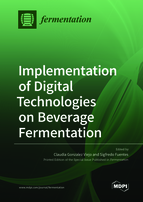Implementation of Digital Technologies on Beverage Fermentation
A special issue of Fermentation (ISSN 2311-5637). This special issue belongs to the section "Fermentation for Food and Beverages".
Deadline for manuscript submissions: closed (30 November 2021) | Viewed by 56744
Special Issue Editors
Interests: food science and engineering; sensory science; computer vision; sensors; robotics; machine learning; artificial intelligence
Special Issues, Collections and Topics in MDPI journals
Interests: digital agriculture; food and wine sciences; plant physiology; remote sensing; climate change; robotics applied to agriculture and computer programming
Special Issues, Collections and Topics in MDPI journals
Special Issue Information
Dear Colleagues,
The implementation of digital technologies such as artificial intelligence (AI), computer vision, machine learning, sensor arrays, and biometrics, among others in the food and beverage industries has been growing due to the need for more reliable, affordable, objective and rapid techniques to achieve more efficient and effective processing methods as well as to increase the final products quality. Specifically, for fermented beverages, the application of these new and emerging technologies in the production process, especially in the fermentation stage, is of utmost importance as it defines the final products quality traits.
This special issue is focused on the scientific reporting and high-quality papers based on the development and application of digital technologies on the beverage fermentation monitoring, and improvement of processing performance and products quality and acceptability. These monitoring processes and improvements may be related to parameters such as physicochemical, foamability and bubble structure and dynamics, development of volatile compounds such as those related to aromas, carbon dioxide production and release, chemical fingerprinting, and sensory profiles from trained panels or consumer tests.
Dr. Claudia Gonzalez ViejoProf. Sigfredo Fuentes
Guest Editors
Manuscript Submission Information
Manuscripts should be submitted online at www.mdpi.com by registering and logging in to this website. Once you are registered, click here to go to the submission form. Manuscripts can be submitted until the deadline. All submissions that pass pre-check are peer-reviewed. Accepted papers will be published continuously in the journal (as soon as accepted) and will be listed together on the special issue website. Research articles, review articles as well as short communications are invited. For planned papers, a title and short abstract (about 100 words) can be sent to the Editorial Office for announcement on this website.
Submitted manuscripts should not have been published previously, nor be under consideration for publication elsewhere (except conference proceedings papers). All manuscripts are thoroughly refereed through a single-blind peer-review process. A guide for authors and other relevant information for submission of manuscripts is available on the Instructions for Authors page. Fermentation is an international peer-reviewed open access monthly journal published by MDPI.
Please visit the Instructions for Authors page before submitting a manuscript. The Article Processing Charge (APC) for publication in this open access journal is 2600 CHF (Swiss Francs). Submitted papers should be well formatted and use good English. Authors may use MDPI's English editing service prior to publication or during author revisions.
Keywords
- Sensors and sensor networks
- Machine learning
- Artificial intelligence
- Computer vision
- Non-invasive sensing technology
- Electronic noses and tongues
- Sensory biometrics
- Robotics







